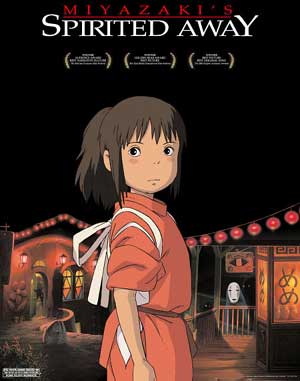 Hayao Miyazaki’s Spirited Away transcends so many categorical limitations that you almost fear to trot out the usual descriptors, lest people get the wrong idea about just how stunning and enjoyable this movie is. It might do just as well to call it "perfect" and leave it at that, but perhaps a little amplification is due.
Hayao Miyazaki’s Spirited Away transcends so many categorical limitations that you almost fear to trot out the usual descriptors, lest people get the wrong idea about just how stunning and enjoyable this movie is. It might do just as well to call it "perfect" and leave it at that, but perhaps a little amplification is due.This animated feature from Japan is the story of a 10-year-old girl, Chihiro, who stumbles into an abandoned amusement park, only to discover that it’s the playground of hundreds of spirits. Presided over by an imperious witch, the park, which is built around a bath house, becomes the girl’s unhappy home till she can find a way to rescue her parents, who have been bewitched and turned into a pair of hogs. As she tries to accomplish this, she undergoes a series of distracting adventures, some with romantic overtones featuring a magical boy who may be a friend or just one of the witch’s henchmen.
Miyazaki is well known to fans of anime, the Japanese form of animation which only a decade ago was known, in its most accomplished forms, to only a handful of enthusiasts outside of Asia. Now, of course, nearly every American teenager you meet can rattle off a history of the form thanks to video, DVD, and U.S. networks which have both imported anime and produced their own versions of it. If, somehow, you still haven’t caught up with it, a prime difference between anime and American animation – when both forms are at the top of their games – is that anime puts more of premium on graphic design than does American animation, and less on the illusion of lifelike motion or continuous action.
But you lose a lot if you approach Miyazaki as a merely representative figure. He possesses an arresting visual signature, based on a highly individualized combination of Japanese architecture and Victorian illustration. Not that his compositions have any sense of ordered synthesis; if these were ever mere copybook models for Miyazaki, he must have surpassed that stage long ago. As they emerge from his brush, these two apparently foreign (to each other) design systems merge with a strange, natural simplicity into something lively and new. This isn’t just a matter of background, but of character animation, too. Although they answered to, say, the round-mouthed convention of anime character-drawing, there are always strictly Miyazakian elements to the director’s characters.
In his last feature, Princess Mononoke (which was distributed in the U.S. by Miramax), both influences seem to have been overtaken by a phantasmagoria set in a world where natural settings gave rise to magical beings. But these amorphous creatures, with their translucent, jelly-fish like bodies, merely overwhelm the earlier influences temporarily. Though diminished, they were still present.
Abandoning the full-fledged mythology of Princess Mononoke, Miyazaki has achieved a remarkable artistic synthesis in Spirited Away, rolling up a lifetime of artistic preoccupations into one film. That’s rolling up, though, not summing up. There’s no sense of sunsets and farewells, here. This is a lively and enchanting film, whose sense of surprise is thunderous. It features that rare moment when an artist unleashes all the forces at his control, but under that control.
The film’s emotions and images rise, fall and rise again in perfect calibration. Chihiro’s discovery of the terrifying place she’s entered, her integration into its routine, and, best of all, her bantering relationships with her various keepers, displays an enormous understanding of how childhood’s fears and resilience have a gear-like relationship. As figures on the screen, the spirits of the bathhouse – which include a rutabaga spirit and a stink (i.e., fecal) monster – and the more corporeal beings that serve them may be astonishing, frightening, appealing, or comical, but always arresting and diverting.
These character designs reach an apex with the evil witch, Yubaba, who reigns over the park. She’s a graphic wonder, squat and fat-headed, outrageously out of scale, and the movie’s most distinct Victorian evocation. If she reminds you of a missing queen from Alice in Wonderland, it’s not a bad thought to have, though she stands on her own as a graphic invention. When she turns into a bird, the better to spy one her domain, Miyazaki sends her wheeling high into some gray-blue clouds, over his echt-Japanese structures, lit from within by yellow lights growing every more steadily bright in the growing darkness. Just brilliant.
More than Princess Mononoke, Spirited Away is a children’s tale, though it has the resonance of a classic. As a classic, it resists simple interpretation; you can’t point to a simple moral or psychological interpretation or meaning, only to a panoply of them, as well as to a host of artistic accomplishments to which they’re inextricably bound. Take it for anime or not as your taste leads you, but don’t miss it.
